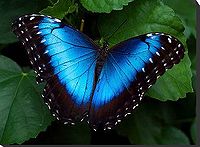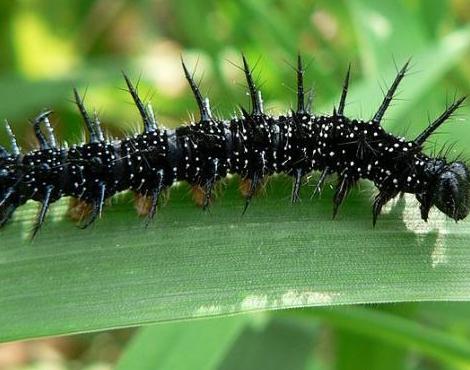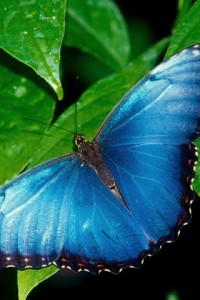Hahk'Loa
From Mizahar Lore

| "Never, EVER piss off a tiger. It'll be the last thing you see - no ifs, mights, or maybes about it." - Tianna of the Bloody Arrow, Myrian soldier |
| Beast | |
 | |
| Frequency | Common within Caiyha’s Temple, Rare throughout Taldera |
|---|---|
| Threat level | Varies |
| Major features | (Adult) ethereal, vibrant, phosphorescent wings; strong scents and odors; metamorphosis; chime-like mating sounds (Larva) poisonous barbs; silk production |
| Abilities | potent poison; soothing pheromones |
| Most common in | Caiyha’s Temple |
The Hahk'Loa is a native butterfly of the Temple of Caiyha. It is known for its phosphorescent coloring, its mood altering powders, and its lethal poison. This creature is extremely loved by all Spirians, and any found purposefully harming one will usually receive one of the Judgments.
Contents |
Life Cycle
Larval Stage
The life cycle of a Hahk’Loa begins from an egg hatching during early spring. Once hatched into its larva stage, the caterpillar is free to graze on the temple’s flora. The Hahk’Loa larvas are black as the night with a furry appearance. Small, thin barbs on the caterpillar are part of a self defense mechanism. Being pierced by any barb causes a reaction in the caterpillar’s body. The Hahk’Loa undergoes a series of chemical reactions that bloats the caterpillar and forces poison out through the barbs along its body. Once injected into a predator, the poison works its way to the attacker’s heart. The unique design of the poison begins to deteriorate the cardiac muscle in the heart, ultimately leading to heart failure. Ingestion of the larva produces a similar, more potent effect. The reactions even produce chemical burns in the predator’s mouth. The potency of the poison is limited to a few minutes before it’s neutralized. The poison is in constant production, freely leaking through the barbs without contact. In such amounts, however, the poison is far less potent and neutralizes itself in seconds. Any of the poison that seeps through the barbs eventually becomes as harmless as sugar water. Fortunately, the larva spend all of their time in the upper expanses and walls of the temple, generally out of reach of anyone within the temple. Very rarely do the larva venture to lower areas or the ground floor, although they can. Larva will feed for the duration of the summer before it starts to produce thin silken nests in the fall. Caterpillars will make joint nests before their metamorphosis into the chrysalis stage.
Chrysalis Stage
A single Hahk’Loa larva once fattened and ready will attach itself to a leaf within the silk nest. Inside it will attach itself to a leaf and begin to coat itself in this silken web that will eventually harden to the chrysalis. Through the remainder of the fall and all of winter, the caterpillar larva will undergo a drastic change in its appearance. Nearing the end of the winter season, the chrysalises and nests begin to faintly glow with a blue phosphorescent appearance, a sign of maturity in the Hahk’Loa and the coming emergence of their adult stage.
Adult Stage
Come spring again, the dew ridden nests burst with life as the Hahk’Loa bloom. The Hahk’Loa is now a butterfly variation with ethereal blue wings, to the touch a texture of gossamer, which Syna’s light both pierces and reflects off of. Initially emerging from the chrysalises, the Hahk’Loa maintain their poisonous properties on their wings. The poison is on their wings. Though not deadly to touch, should an individual whip the wing and then touch his tongue, ah there…there is a dead man. The poison is not light enough to be whipped off onto leaves. Once the Hahk’Loa engage in their first nectar meal, the once deadly poison is neutralized. The now neutralized poison forms as a light powder –characterized by its floral scent - on the Hahk’Loa’s wings that’s given off as it flies. This powder is known to induce calming behavior, but again only so long as it is freshly produced. Unfortunately for the Hahk’Loa, the neutralization of their poison makes them incredibly vulnerable to predators.
When Leth rises over Syna, another beautiful sight comes to life. The wings of the Hahk’Loa glow a blue phosphorescent light throughout the entire temple and over Spires. The light is too faint to pierce more than a few feet of the canopy. However, in large collections like those in the temple, the evening mood is set by the soft radiance of their wings. Spring emergence also signals a new mating season. At night, the Hahk’Loa rub their leg as thin, moist hairs produce a sweet sounding chimes and tones. This mating ritual will result in life time bonds as the Hahk’Loa mate and produce hundreds fertile eggs to renew the life cycle. The Hahk’Loa freely spend the duration of their lives in the temple.
After a life span of five years, a Hahk’Loa generation will begin to wilt. When their time has come, typically during their fifth summer, they leave Spires to the farthest reaches of Taldera to the west, south, and east. Social Structure: Mass colony in Caiyha’s Temple, Spires.
Outside of Caiyha’s Temple
No larvae or pupal stages exist outside of Spires. Any specimens ceased from the temple prematurely die within a week, or a week after emerging from the chrysalis. Adult variations hatched outside of the temple are equally potent in their poison. No floral species outside the temple, even if retrieved from the temple, will nullify this poison.
Wilting Hahk’Loa after five years of life flee the temple of Caiyha. Sometime after their time is up, the Hahk’Loa begin to display bizarre behavior such as involuntary wing movements, awkward flight patterns, and inability to cling to foliage. The Hahk’Loa seek refuge elsewhere in the Talderan wilderness. This flow of generations, in addition to natural selection, maintains the equilibrium of the temple’s population.
Wilting
Outside of Spires, the Hahk’Loa roam in search of more suiting conditions in vain. All awkward behaviors continue and worsen as time advances. The flower-sweet pheromones cease to be produced, and the deadly poison takes back over the Hahk’Loa’s body. The Hahk’Loa slowly begins to bloat. During this time, the butterflies also lose their coloration. The vibrant blues begin to dull, the blacks becomes grays, and the wings begin to take on a red tint. This is a clear sign of the poison build up in the Hahk’Loa’s body in addition to a rotting scent of the decomposing poison. Ingestion of the Hahk’Loa becomes deadly once more, as well as ingestion of the poison from the wings. By this point in the Hahk’Loa’s metabolic cycle, its body begins to produce at too rapid a rate. Now immune to its own poison and without any ways to excrete the substance, the buildup in its body will eventually cause a burst in the Hahk’Loa’s exoskeleton when it will bleed to death. This is the most common end of the Hahk’Loa, and comes within weeks of leaving the temple.
Defying Death
In cases beyond any divine explanation, there are instances when the Hahk’Loa survives. Breaks in the wings allow for the constant oozing of the poison and brings the Hahk’Loa back to an internal equilibrium. The bloating ceases and the wings are still light and dry enough to fly. Abnormal behaviors continue unfortunately. As the last substances of divinity are driven from its body, the presence of the poison reveals its true nature. The Hahk’Loa’s wings turn sanguine. The Hahk’Loa still appears to retain its phosphorescent capabilities as its wings now glow a brilliant red through the night air. The outstanding coloration and nighttime signal number the days of lucky Hahk’Loa further, as well as the predator bound to consume it… Reproduction of the Hahk’Loa outside of the temple is a rarity, though possible. Considering the small numbers of survivors, off mating season, other environmental and biological factors, the survival of populations outside of the temple are nearly impossible. The existence of such a group is rumored to exist somewhere in the Talderan wilderness, although the Jamoura would consider them something new, a species that transcends the natural order known to them as Hahk’Gal. Such a population might be considered a whole new species that would require the security of isolation and the nutrition of Caiyha’s Temple. Even then, the longest time a Hahk’Gal can reap from life is roughly thirteen years.
Cultural Impact
The Hahk’Loa have existed as long as Caiyha’s Temple, as has its vicious cycle which brings and takes life as nature wills. To some, the Hahk’Loa might be considered the true guardians of the temple, a final defense against invasive species or other naïve trespassers. The Hahk’Loa and Hahk’Gal are revered as the temple is itself, and thus leave them to their own. Their persisting existence is another sign of nature’s balance and the health of the temple’s flora. Interfering with the life cycle of the Hahk’Loa is punishable by a Judgement.
| Out of character note: TExT HERE |





